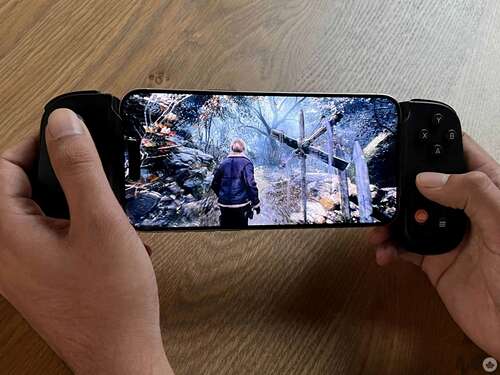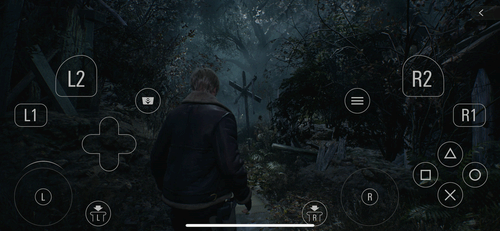Whenever you hear about “console-quality” gaming on mobile, that usually means one of two things.
Either it’s a company overexaggerating the graphical fidelity of a game that was still inherently made for mobile, or it’s an actual console title that’s being streamed to your smartphone or tablet. In the case of the former, it’s really just marketing speak, and in the latter, it’s an admittedly impressive but nonetheless uneven experience due to connectivity and latency issues.
What Apple is doing with gaming on iPhone, though, circumvents both those issues to deliver truly “console quality” games. That’s all possible thanks to the iPhone 15 Pro and Pro Max’s beefy A17 Pro chips. These components offer up to 20 percent faster GPU with 6 cores, 10 percent faster CPU with 6 cores, up to four times faster ray tracing than the A16 Bionic and up to a two times faster Neural Engine.
That’s a lot of tech jargon, but to put it simply, the A17 Pro allows for console games to be played natively on iPhone 15 Pro and Pro Max. Not through streaming or an alternate pared-down version — natively. It’s one thing to hear that, and it’s another to actually experience it. At a recent media event, Apple showcased a variety of games across iPhone, iPad and Mac, but the one I keep coming back to is Capcom’s Resident Evil 4 (2023) on iPhone.
The remake of the beloved GameCube classic is one of my favourite games of the year thanks to its gorgeous presentation, snappy third-person combat and effective narrative changes, so it was what I was most interested to see on iPhone. After all, how does that beautiful, action-packed experience translate to an iPhone?
Quite well, as it turns out, based on some hands-off gameplay I saw. At the event, Capcom showed off the beginning of RE4 on iPhone when U.S. special agent Leon S. Kennedy arrives in the Spanish countryside to rescue Ashley, the president’s daughter. On the one hand, I wished I was also able to get a glimpse at a later point in the game, but this is still an effective place for the demo. That’s because this area is all about ambiance, an eerily slow trek through the dilapidated hills to ratchet up the tension.
 Here, I could really appreciate just how well Capcom’s stunning RE Engine, known for producing sharp photorealistic visuals on console and PC, works on the smaller screen. Outside of some aliasing in places, particularly Leon’s hair, RE4, on the whole, looks remarkably crisp on iPhone, from the thin rays of moonlight piercing the dank and foggy pathways to the blood of a festering carcass glistening in a pool of water.
Here, I could really appreciate just how well Capcom’s stunning RE Engine, known for producing sharp photorealistic visuals on console and PC, works on the smaller screen. Outside of some aliasing in places, particularly Leon’s hair, RE4, on the whole, looks remarkably crisp on iPhone, from the thin rays of moonlight piercing the dank and foggy pathways to the blood of a festering carcass glistening in a pool of water.
The only thing that took away from the atmosphere, through no fault of RE4 or the iPhone, was the loud and crowded media room I was in. I also didn’t get a chance to hear any audio, which is especially important for a survival horror game. Of course, that wouldn’t be an issue for most people, though, and I could especially see this mobile version of RE4 working well if you’re taking transit home at night or even in your bed with headphones.
What I definitely don’t think will be effective under any circumstance are the touch controls. Truthfully, I didn’t get to try them for myself, but just looking at the garish and obtrusive interface puts me off. In any case, RE4 is a pretty fast-paced action game, so it’s hard to see how well you’ll be able to juggle moving, sprinting, aiming, shooting and more with just the touchscreen. Thankfully, you can connect Bluetooth controllers like the PS5’s DualSense controller or accessories like the BackBone to eliminate that barrier.

Not the best touch interface. Image credit: Capcom
That will no doubt prove essential in the frenetic action scenes, which regularly challenge Leon with fighting several infected enemies at a time and, in some cases, also worrying about Ashley being picked up and taken away. One of the highlights of the remake’s gameplay is the new knife parry, which lets you block incoming melee attacks and projectiles with a well-timed button press. It’s easy to see how you’d often just fail that with touch controls.
What I didn’t get much of a bearing on, however, is the frame rate. Of course, it’s one thing to maintain a smooth experience when Leon’s just walking through enemy-free areas; it’s another when there’s a lot more happening on-screen. I did see some combat footage featuring just two or three enemies at once, and that looked solid. The balletic rhythm of shooting an enemy in the kneecap, kicking them while stunned to the ground and then rushing up for a finishing head stab certainly remains oh-so-satisfying and polished on iPhone.
But it’s the later moments, like the hordes of enemies who rush you in the village, the mid-game mine cart sequence, or the towering, stage-altering boss fights, that will really test the iPhone’s capabilities. Some brief trailer footage we’ve seen looks decent, but I’ll need a more extended look before I’m convinced. If nothing else, though, the fact that the game is running natively means that some dips in resolution or framerate, especially during more intense moments, shouldn’t be nearly as common or significant as what you’d experience via streaming.
“…after having a taste of RE4 on mobile, I’m excited to see what other high-end gaming experiences we get from the new iPhones.”
What helps Apple’s case for iPhone gaming is the fact that it has a ‘Universal Purchase’ program. This means you can buy supported games like Resident Evil 4 once and play them across iPhone, iPad and Mac and have your progress carry over. Given that there are many people who have at least two types of Apple devices, it makes something like RE4 even more appealing.
On the whole, Resident Evil 4 on iPhone is one of the most impressive mobile gaming experiences I’ve ever seen, but I say that with some trepidation. To start, the iPhone 15 Pro and Pro Max are at least a few hundred dollars more than the base iPhone 15 models. Clearly, then, they’re not quite as accessible as a result, especially when the other iPhones can play pretty much any other game, including what’s available in Apple’s surprisingly expansive Apple Arcade catalogue.
The second concern pertains to how many other games will get the RE4 treatment on iPhone. So far, other confirmed iPhone 15 Pro-exclusive titles include Resident Evil Village, Assassin’s Creed Mirage and Death Stranding: Director’s Cut. Those are all quality titles, but it’s not exactly a large list, and only time will tell how many other companies will follow suit.
That’s important information because if the iPhone 15 Pro gets wider support for these kinds of AAA games, then it’ll be easier to justify the higher entry cost knowing there’s more to come. I only own an iPhone 13 Pro, but I’d happily make the upgrade if I was sure there’ll be a lot more ports.
That said, the iPhone 15 Pro and Pro Max aren’t even two months old yet, so there’s still plenty of time to get more. And after having a taste of RE4 on mobile, I’m excited to see what other high-end gaming experiences we get from the new iPhones.
Resident Evil 4 releases on iPhone 15 Pro and Pro Max, iPad and Mac on December 20th.
Header image credit: Capcom


